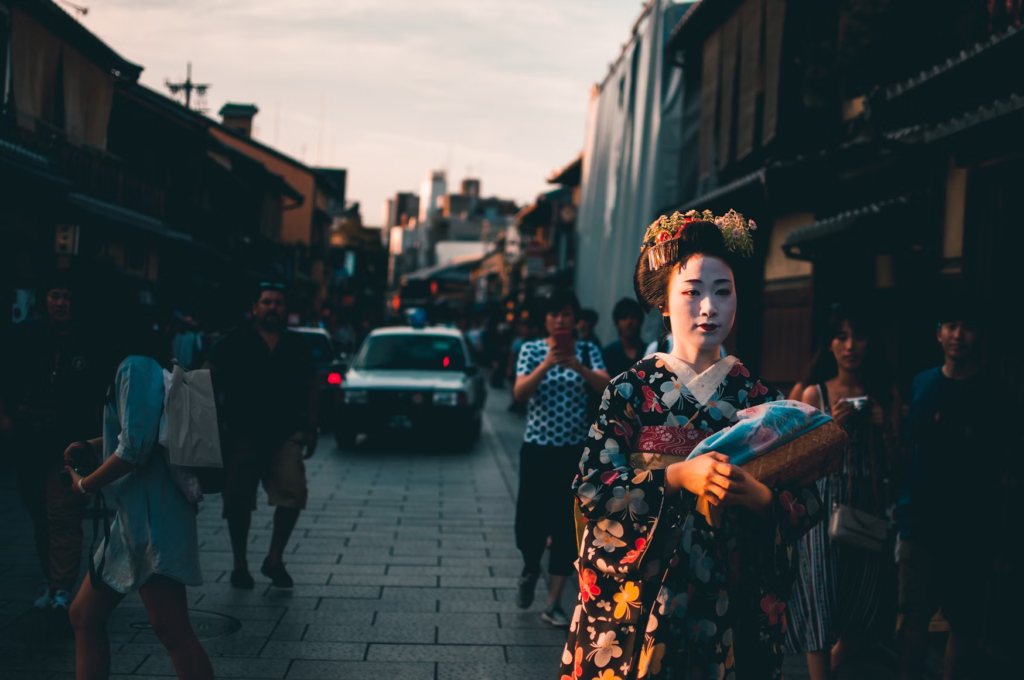
Why Japan Is Tightening Tourism Rules — and What Happens If You Don’t Follow Them
Japan has long been a dream destination — neon-lit cities, tranquil temples, world-class cuisine, and stunning landscapes. But with record-breaking tourist numbers, the country is facing a new challenge: too much of a good thing.
The surge in visitors has brought huge economic benefits, but it’s also caused overcrowding, damage to cultural sites, and tension with local communities. Streets in Kyoto’s geisha districts have become so packed that locals can barely pass. Mount Fuji’s trails are suffering from litter and safety issues. Even small rural towns are overwhelmed by buses and noise.
To protect its heritage and keep tourism sustainable, Japan is introducing stricter rules and systems:
Real-life examples of new measures
- Mount Fuji climbing fee and daily cap: Visitors to the Yoshida Trail must now pay a ¥2,000 fee and numbers are limited to reduce congestion and trash.
- Photography bans in Kyoto’s Gion district: Taking photos on certain private lanes is prohibited to protect geisha and residents’ privacy.
- Stricter rules on short-term rentals: Illegal Airbnbs face fines, and travelers risk losing their bookings if the property isn’t registered.
- Tourist taxes in major cities: Places like Kyoto have added accommodation taxes, and some regions are considering day-pass fees for heavily visited sites.
- Crowd control in popular areas: Some buses and tourist sites now require timed reservations.
What if you ignore these rules?
Japan is known for its politeness, but authorities are becoming firm about enforcement:
- No reservation, no entry at controlled sites or buses.
- On-the-spot fines for trespassing or breaking photography bans.
- Loss of accommodation if staying at an unlicensed rental.
- Repeat or serious offenders could face police warnings — and in rare cases, even refusal of entry at immigration if laws are broken.
The message is clear: Japan still warmly welcomes visitors — but on the condition that travel is respectful and sustainable. Following these new guidelines isn’t just about avoiding penalties — it’s about helping preserve the places that make Japan magical.
New Rule No. 1 – JAL’s Mobile Battery Policy Update — Effective July 8, 2025

What’s Changing & Why
- No More Overhead Compartment Storage
JAL now requires that power banks (portable battery chargers) be kept on your person or in an easily monitored space—not in overhead bins. This is due to fire risks from lithium-ion batteries overheating or emitting smoke mid-flight. - Carry-on Only — Never Checked
Power banks remain strictly prohibited in checked baggage. They must be carried in your hand luggage only. - Capacity Limits
- Up to 100 Wh: Allowed, no approval needed.
- 100–160 Wh: Permissible, but limited to 2 units per passenger, and corporate approval may be required.
- Over 160 Wh: Completely banned from all flights.
- In-Flight Charging = Under Watchful Eyes
You can charge devices or the power bank mid-flight, but only if it’s in a visible location—like on your lap or in the seat pocket—so any issues are noticed immediately.
What Happens If You Don’t Comply
- Denial of Boarding or Confiscation
Power banks that exceed Wh limits, or those packed incorrectly (like checked in, or placed in overhead bins), could be confiscated or lead to boarding denial. - Fines & Flight Delays
Non-compliance might trigger fines or cause flight disruptions, such as cabin inspections or delayed departures. - Safety Risks
Overhead storage increases the danger of delayed detection of battery malfunctions—this policy minimizes those risks by keeping batteries in immediate view.
Why This Matters (Real-World Context)
- Incidents involving lithium battery fires have occurred globally, including one on Air Busan during boarding that led to injuries. Japan is stepping up its safety standards in light of these scares.
- The Japan Civil Aviation Bureau (JCAB) and the Scheduled Airlines Association of Japan aligned this update with ICAO and FAA safety guidelines.
Practical Checklist Before You Fly
| Item | Recommendation |
|---|---|
| Capacity Verification | Confirm your power bank is under 160 Wh. Preferably under 100 Wh. |
| Carry-On Only | Never pack in checked baggage. Keep it with you. |
| Visible Placement | Place it under the seat, in the seat pocket, or on your lap. |
| Limit Quantity | Max 2 units if between 100–160 Wh; none above 160 Wh. |
| Protect the Terminals | Insulate exposed ends with tape, a protective pouch, or the original packaging. |
| During Charging | Watch your device—no leaving it unattended in a bag or overhead bin. |
New Rule No. 2 – Oversized Baggage On Shinkansen

What’s New? The July 1, 2025 Pilot Update
- New walk-in oversized luggage storage (“Oversized Baggage Compartment”)
Starting July 1, 2025, passengers on the Tokaido and Sanyo Shinkansen can use the oversized baggage compartments without a prior seat reservation, on a trial basis. - These compartments are located in the connecting passageways of 16-car trains (e.g., between cars 3, 5, 7, 9, 13, and 15) and are clearly marked.
- Reserved seat storage is still required
The “seat with oversized baggage area”—i.e., the storage space behind the last row of seats—still requires a reservation as before.
Overview: What This Means for Travelers
| Storage Option | Reservation Required? | Notes |
|---|---|---|
| Oversized Baggage Compartment | No (trial begins July 1) | First-come, first-served deck storage next to washrooms/passages |
| Oversized Baggage Area (behind seat) | Yes, as before | Requires a reserved last-row seat; shared area |
- No fee is added—the compartment remains free to use.
- If all compartment spaces are occupied, passengers with oversized baggage should still reserve the seat-area option in advance.
- JR Central recommends boarding early to secure a spot during the trial, especially during peak travel periods.
Why This Matters
- Better convenience & flexibility
This update simplifies travel for visitors with bulky items, such as strollers, large suitcases, or sports gear—without the stress of booking specific seats. - Supports peak tourism
Acknowledges the growing inflow of travelers. The pilot aims to improve the onboard experience during summer vacations and holiday seasons. - Still a trial
Duration beyond July is TBD—expansion to additional lines may depend on feedback and usage.
Quick Tips for Travelers
- Arrive early to improve chances of using the new walk-in compartment.
- If flexibility is critical, still reserve a seat with baggage area—especially for long trips or during holidays.
- Measure your luggage: If it’s between 160–250 cm, it qualifies as oversized and must be stored in the designated area.
- Watch for signage on board—compartment spaces are marked near passageways.
- Stay updated—trial conditions may evolve, so check JR Central and official platforms before traveling.
New Rule No. 3 – Foreign Travelers Will Need Valid Travel Health Insurance To Enter The Country

What’s Changing: Mandatory Health Insurance for Entry
- As of mid-2025, Japan is proposing to require all foreign tourists to present proof of private health insurance upon entry, aiming to reduce the growing burden of unpaid medical bills on Japan’s healthcare system.
- Around 0.8% of foreign patients across Japanese hospitals in 2024 did not pay their bills, resulting in ¥61 million (US$425,000) in unpaid expenses.
- The Ministry of Health, Labour and Welfare (MHLW) will work with the Immigration Services Agency to screen visitors for unpaid medical debts and mandate insurance coverage.
Why Japan Is Taking This Step
- The volume of international tourists post-pandemic has surged—straining hospitals and clinics, especially when visitors leave without settling medical costs.
- Japan is aligning with global practices. Countries and regions like the Schengen Area, Russia, Cuba, Uruguay, and Costa Rica—and even Switzerland and Iran—already require tourists to have health insurance upon entry.
Real-World Impacts for Travelers
- Proof of insurance may be required at immigration checkpoints or visa applications for short-term visitors.
- Travelers with a history of defaulting on medical bills could face entry denial or additional screening.
- If you lack the required coverage, you might be refused entry or forced to purchase local coverage at the airport, as seen in other countries like Cuba.
Quick Overview
| Topic | Details |
|---|---|
| Requirement | Proof of valid private travel health insurance is required for entry |
| Reason | To prevent financial burden from unpaid medical bills |
| Tracking | Immigration may screen for past medical debt default |
| Consequences | Entry denial, forced local policy purchase, or extra screening |
| Global Context | Aligns Japan with other countries enforcing mandatory coverage |
Traveler Tip: Prepare Now!
Even though formal legislation and implementation timelines are pending, planning ahead is wise:
- Buy travel insurance before departure—don’t wait for signs that it’s mandatory.
- Ensure your policy includes adequate medical, emergency, and repatriation coverage.
- Keep digital or printed proof in your carry-on for easy access.
- If you’ve previously visited Japan and received medical care without paying, consider addressing any defaults before reapplying for entry.
New Rule No. 4 – Japan’s New Airport Entry System — What’s Changed in 2025

1. One-Stop Entry Kiosks
Japan has introduced combined immigration and customs kiosks, known as Joint Kiosks, at major airports:
- Available at Kansai International Airport (Terminals 1 & 2) from April 1
- Haneda (Terminals 2 & 3) followed on April 1 & 11
- Narita Terminal 3 added from April 7
These kiosks allow visitors to complete immigration and customs in one go—no more separate queues. Simply scan your passport and QR code (from Visit Japan Web), submit a photo and fingerprint (for foreign nationals), and breeze through.
2. Facial Recognition Walkthrough Gates
To further speed up processing, NEC’s biometric “walkthrough gates” are now live at:
- Haneda Terminal 3
- Narita Terminal 3
- Kansai Terminal 1
These gates use NEC’s high-accuracy Bio-IDiom Edge Software, enabling frictionless facial recognition-based identity checks. They eliminate manual passport stamping and streamline arrivals.
3. Pre-Registration via Visit Japan Web
Travelers are encouraged to register their details—passport info, flight, accommodation, etc.—through Visit Japan Web before arrival:
- After registering, you receive a QR code to scan upon arrival
- Cuts down wait times significantly by bypassing traditional paper forms
This system isn’t mandatory, but highly recommended—especially during peak travel periods.
Why This Matters: A Faster, Smarter Arrival
- Streamlined Process
No more juggling separate customs and immigration areas—everything is integrated into a smoother, single flow. - High-Tech Efficiency
Biometric walkthrough gates and automated kiosks reduce staffing needs and speed up processing, letting travelers pass in seconds. - Reduced Queues and Safer Travel
These upgrades were introduced ahead of Expo 2025 Osaka and Japan’s target of welcoming 60 million visitors by 2030—to prevent long lines and enhance border efficiency
Quick Comparison Snapshot
| Feature | What It Does |
|---|---|
| Joint Kiosk (Immigration + Customs) | One-stop scanning using passport + QR code—streamlines both steps |
| Walkthrough Gates | Rapid biometric entry using face recognition—minimal interaction |
| Visit Japan Web | Pre-register, get QR code—skip paperwork and save time |
New Rule No. 5 – TAX-FREE SYSTEM Is Changing

What’s New
1. April 2025 update:
From April 1, 2025, if you ship your purchases home via international courier (like FedEx or DHL), you’re no longer eligible for a tax exemption. Your items must physically leave Japan with you to qualify.
2. Big revamp in November 2026:
Japan is switching from point-of-sale exemptions to a tax refund system:
- Pay full price (including consumption tax) at the store.
- Claim your refund at departure, once customs confirms the items are leaving with you.
- Removed limits and packaging rules: No more separate consumable vs. general goods categories, no minimum or maximum purchase thresholds, and no special packaging required.
This aligns Japan’s system with global VAT/GST refund models.
Why This Update Matters
- Curbing Fraud & Resale Abuse
The old system was vulnerable—some tax-free purchases were never taken abroad, undermining the policy. - Encouraging Fairer, Simpler Shopping
Eliminating packaging and spending limits makes shopping smoother and more inclusive for all visitors. - Modernizing Operations
A refund-based model enhances oversight and prepares Japan for tourism growth, including post-Expo 2025.
What This Means for You: Traveler Tips
- April 2025 Onward: Don’t ship tax-free items home—carry them on yourself to qualify.
- Starting November 2026:
- Expect to pay tax at checkout, then claim a refund at the airport.
- No more minimum spend or confusing packaging rules.
- Even small purchases will be eligible—shopping gets way easier.
- Before then:
- Continue enjoying point-of-sale tax exemptions.
- Ensure you have your passport, original receipts, and know whether your purchase qualifies under current rules.
New Rule No. 6 – Advance Reservation Rules for Major Attractions in Japan

What’s New & Why It Matters
Japan is increasingly requiring advance reservations for high-demand attractions to address challenges like overcrowding, overtourism, and improving visitor experience. Solid examples of this shift include:
- Mount Fuji (Yoshida Trail): A paid reservation is now required between July 1 and September 10, with a ¥2,000 fee and a 4,000-person daily cap. Bookings started May 20. This replaced the prior voluntary system to better manage hiking traffic and preserve the environment.
- Iconic attractions & venues like Shibuya Sky, teamLab Planets, Ghibli Museum, and theme cafés such as Pokémon Café or Kirby Café now require booking weeks or even months in advance—often due to limited capacity and overwhelming demand.
Which Attractions Commonly Require Reservations?
| Attraction Type | Examples |
|---|---|
| Art & interactive museums | teamLab Planets/Borderless, Yayoi Kusama Museum |
| Theme cafes & character experiences | Pokémon Café, Kirby Café, Studio Ghibli Museum |
| Observation decks & skyline views | Shibuya Sky, Tokyo Skytree, Tokyo Tower |
| Theme parks & unique experiences | Universal Studios Japan (especially express passes), specialized museum workshops (like Cup Noodles) |
| Historic tours & cultural sites | Imperial Palace tours, some special temple or tea ceremony experiences |
Why Advance Booking is Now Essential
- Crowd control & preservation: High-traffic sites like Mount Fuji launched reservation systems to limit visitors and protect the environment.
- Enhanced visitor experience: Reducing lines and overcrowding helps ensure smoother visits at major attractions.
- Predictable planning: With the post-pandemic tourism rebound and major events like Expo 2025, Japan is prioritizing more organized visitor flows.
What You Should Do Before Your Trip
- Research your “must-do” attractions clearly—find out if they need reservations.
- Book early—some open as early as 60 days before, or sell out within minutes.
- Use official or trusted platforms like Klook, theme museum websites, or authorized partners.
- Set reminders for ticket release dates (e.g., Ghibli tickets release on the 10th of the prior month at 10 AM JST).
- Have backup plans—if a site is sold out, explore other cultural or scenic experiences less likely to require prior booking.
- Check for seasonal or cultural events, like temple illuminations, which may have unique reservation systems.
New Rule No. 7 – New and Existing Restrictions at Japan’s Popular Sites

1. Entry Bans for Certain Visitor Groups
- Watatsumi Shrine (Tsushima, Nagasaki)
In March 2025, following repeated instances of littering, smoking, harassment, and even physical assault by tourists, this shrine banned entry to non-worshippers—including all sightseeing visitors. Photography, video, and live streaming of shrine structures (like its iconic underwater torii gate) were also strictly prohibited.
The message was clear: sacred spaces must be protected—not overrun by tourism.
2. Restricted Access in Kyoto’s Geisha Districts
- Gion and Surrounding Areas
Due to ongoing harassment and privacy violations directed at geiko and maiko—such as rude intrusions into residential alleys—tourists are now prohibited from entering certain backstreets in districts like Gion Kobu, Pontocho, and others.
Look out for clear signage indicating restricted zones.
3. Photography & Behavior Controls at Temples and Shrines
- No Food or Drinks
It’s considered disrespectful to eat or drink (even bottled soft drinks) within temple compounds or inside sacred buildings. Water alone is acceptable, and sipping should be done discreetly outside. - Photography Rules Vary
Many temples allow photos outdoors, but inside sacred interiors—shrines, altars, monk prayer areas—it’s often forbidden, sometimes even without explicit signage. The reasons? Protection of artifacts from light/flash damage, crowd control, and maintaining solemnity. - Modest Dress & Proper Conduct
Though no formal dress code exists, revealing clothing (e.g., off-the-shoulder tops or spaghetti straps) is discouraged. It’s best to dress conservatively, remove hats, and follow purification rituals—especially at inner or smaller rural sites. - Avoid Disruptive Actions
Don’t sit on temple steps, obstruct pathways, or act like “a nuisance.” If taking photos, avoid including worshippers, especially those in prayer. Just “behave like a normal person,” as travelers put it.
4. No Cultural or Fashion-Based Bans—But Respect Still Matters
- There’s no official rule banning fashion hair colors in temples or shrines, although outlandish styles may draw attention—and, in one anecdote, were rumored to have barred entry. In reality, no standardized restriction exists, but it’s wise to err on the respectful side.
Summary — What’s Banned or Restricted at Popular Japanese Sites
| Location / Behavior | What’s Restricted / Prohibited |
|---|---|
| Watatsumi Shrine (Tsushima) | No entry for non-worshippers or tourists; no photos or recordings allowed |
| Kyoto Geisha Districts (Gion, etc.) | Some traditional alleys are closed to tourists; respect the privacy signs |
| Temples & Shrines (General) | No eating/drinking inside; photography often banned indoors; dress modestly |
| Beaches, Steps, Prayer Areas | Avoid sitting, playing, or blocking paths; observe ritual conduct |
| Fashion Choices | No formal bans, but avoid attention-grabbing styles that may be deemed disrespectful |
Tips for a Respectful Visit
- Always check for signs—entrances to restricted zones or no-photo areas are usually marked.
- Pack modest clothing—carry a shawl or layer if visiting sacred spaces.
- Leave food and soft drinks for after your visit.
- Avoid blocking lines or taking pictures of private moments.
- Respect cultural norms, even if there’s no strict rule—better safe than accidentally disrespectful.
New Rule No. 8 – No More Tax-Free Shipping

As of April 1, 2025, travelers can no longer qualify for a tax exemption if they ship tax-free purchases home themselves via postal or courier services. Tax-free eligibility will only apply if:
- You personally carry the items out of Japan and present them at customs during departure; or
- The retailer directly ships the items overseas on your behalf, meeting the tax-free criteria.
Self-arranged shipments will no longer suffice, even with documentation like parcel slips.
If you attempt to ship purchases on your own and don’t present them at customs, you’ll be required to pay the 10% consumption tax, effectively losing the tax-free benefit.
Why the Change?
- Preventing abuse and fraud: Previously, some shoppers could buy tax-free in Japan and have items shipped back later, even if they never personally took possession—undermining the system.
- Ensuring goods actually exit the country with the purchaser, not on the gray market or for resale.
- This change is part of broader updates aiming to streamline the tax-free system and align it with fair-use practices.
Summary Table — What You Can and Can’t Do
| Action | Tax-Free Eligible? | Notes |
|---|---|---|
| Carry items yourself and present them at customs | Yes | Still allowed, must accompany you on departure. |
| Retailer ships items directly overseas | Yes | Tax-exempt if done by the retailer through proper channels. |
| You ship items via courier/postal yourself | No | You lose the tax exemption and must pay the 10% tax. |
- Plan your buys carefully. Only purchase what you can physically carry out, unless the store offers direct shipping.
- Ask at the store if they offer retailer-led export shipping—this remains eligible for tax exemption.
- Bring purchases with you when possible—the tax-free at point of sale only applies if you carry the items with you and can present them to customs.
- Keep documentation ready: receipts, passports, and items themselves must be presented upon departure.
- When in doubt, be conservative. Opt to pay tax on excess goods rather than risk penalties or confusion at customs.
New Rule No. 9 – No More Real Swords for Tourists

What’s the Rule?
In December 2024, Japan’s National Police Agency issued a nationwide directive under the Firearm and Sword Possession Control Law: tourists are no longer allowed to handle real, sharpened swords (katana) as part of tourism activities. This ended popular experiences like tameshigiri (“practice cutting”) and samurai sword-handling sessions, particularly those offered in Murayama, Yamagata Prefecture.
Previously, some programs—especially in Murayama, the birthplace of iaidō—allowed visitors to practice iaidō and even perform tameshigiri using real blades. While these were initially permitted, the new directive clarifies that allowing unregistered individuals (like tourists) to wield registered swords is illegal, even under supervision.
Why the Policy Changed
- Legal Compliance: The Firearm and Sword Control Law strictly regulates sword possession and use for public safety. Even cultural programs offering sword experiences must comply fully.
- Risk Concerns: Authorities cited risks of accidental injury or misuse when tourists handle sharp weapons, despite precautions.
As a result, tourism providers have shifted from hands-on sword experiences to demonstrations where only instructors use sharpened blades, ensuring visitors remain spectators.
Summary Table
| Aspect | Before 2025 | After December 2024 Rule |
|---|---|---|
| Tourist handling of real swords | Allowed in organized settings (e.g., tameshigiri) | Now prohibited under national law |
| Current practice | Tourists demonstrated cutting with a real katana | Only instructor-performed demonstrations permitted |
| Reason | Cultural immersion vs. legal/safety concerns | Legal compliance under the Sword Control Law |
| Recommended alternatives | Hands-on with a real sword | Spectating, wooden sword practice, cultural lessons |
What It Means for You
If you were planning to try blending traditional samurai culture with hands-on sword handling, there are still meaningful alternatives:
- Observe expert sword demonstrations in historic settings rather than participate with real swords.
- Train using practice swords (iaitō)—these are unsharpened, safer replicas permitted under the law and widely used in legitimate martial arts dojos.
- Engage in martial arts lessons, cultural workshops, or museum demonstrations that teach iaidō forms without breaking legal rules.
Staying Updated on Japan’s New Travel Rules
Japan is constantly refining its tourism policies to protect its culture, environment, and the safety of visitors. The rules we’ve outlined here are just the beginning, and more updates may be introduced as the number of international travelers continues to rise.
We’re committed to keeping this page accurate and up to date. As new regulations are announced, we’ll update this guide so you can plan your trip to Japan with confidence and avoid surprises at the airport, attractions, or accommodations.
Check back regularly for the latest information — your smooth and stress-free Japan adventure starts with being informed!